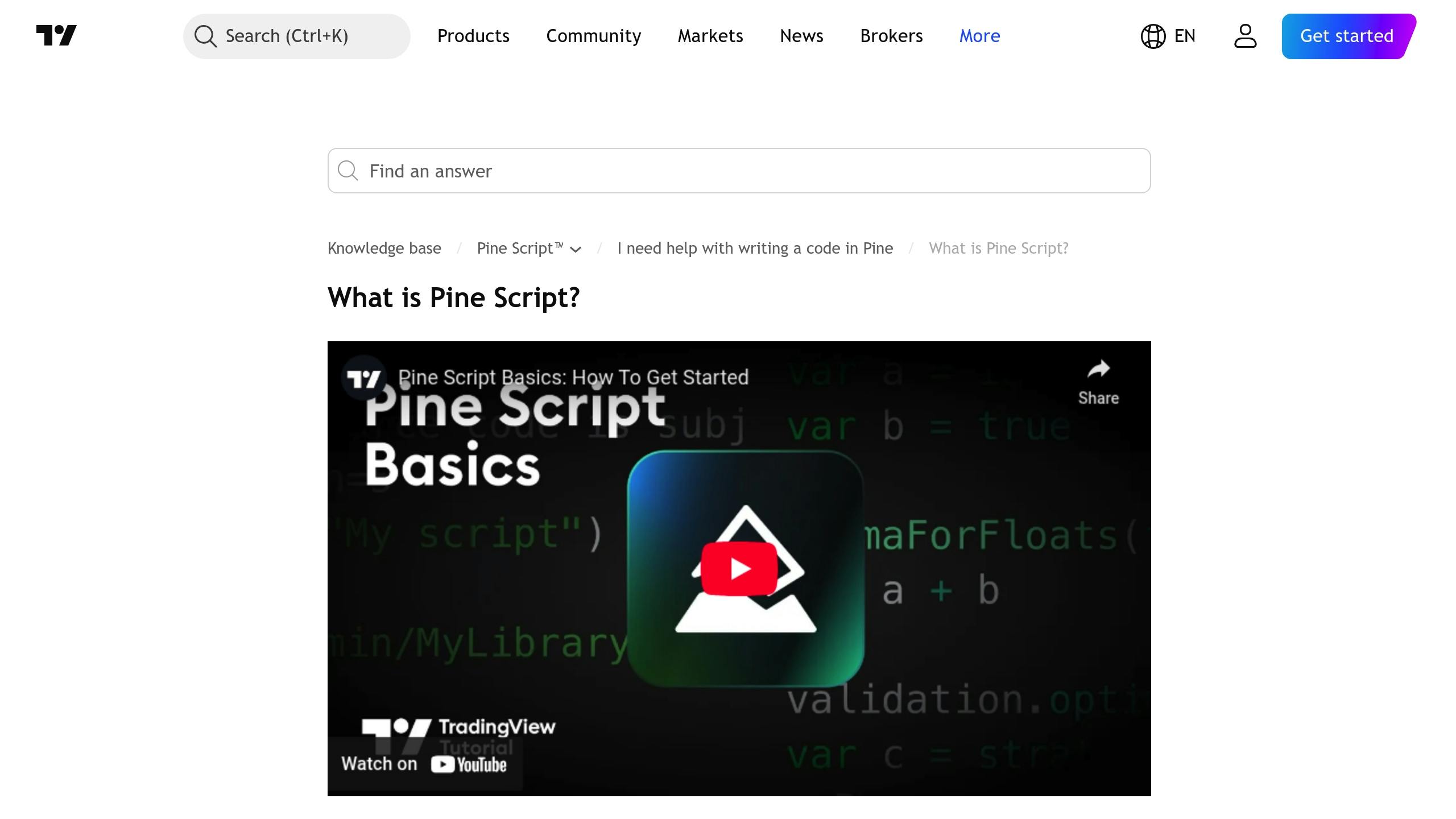Learn the essentials of Pine Script to create custom trading indicators and strategies, enhancing your trading experience with personalized tools.
Pine Script is TradingView’s built-in programming language, designed to help traders create custom indicators and strategies with ease. Whether you’re automating strategies, testing ideas on historical data, or building advanced analysis tools, Pine Script is a must-know for traders. Here’s a quick breakdown:
- What It Is: A simple, market-focused coding language for TradingView.
- Why Use It:
- Automate indicators and strategies.
- Test trading ideas with historical data.
- Access 100 000+ community scripts.
- Save money by creating your own analysis tools.
- Getting Started:
- Create a TradingView account.
- Open the Pine Editor to write and test scripts.
- Start with basic syntax such as
plot(close).
Quick Example
//@version=5
indicator("My First Script")
plot(close)This article covers everything from setup to creating custom indicators and strategies, with step-by-step examples, error-handling tips, and optimization ideas.
Pine Script Basics: How to Get Started

Setup and Basics
Start using Pine Script by setting up your TradingView account and learning its coding essentials. A solid foundation is key to creating effective trading tools.
TradingView Account Setup

Getting started with TradingView is simple. Follow these steps:
| Step | Action |
|---|---|
| Account Creation | Go to tradingview.com |
| Verification | Confirm your email |
| Platform Access | Navigate to /chart |
| Editor Access | Open the Pine Editor |
The Pine Editor provides instant feedback, letting you see your indicators directly on the chart.
Pine Script Basics
Every Pine Script starts with a header and at least one plotting function:
//@version=5
indicator("Variable Examples")
const PERIOD = 14 // Immutable
threshold = input.float(1.5, "Threshold")
var float highest = 0.0 // Persists bar-to-bar
float myValue = na
if close != na
myValue := closeVariables and Data Types
Key types include float, int, bool, string, and color. Control scope with const, var, and input.*.
Functions and Operators
geom_average(x, y) =>
math.sqrt(x * y) // True geometric mean| Category | Operators | Use Case |
|---|---|---|
| Arithmetic | + − * / | Price math |
| Comparison | < > == != | Conditions |
| Logical | and or not | Combine rules |
| Historical | [] | Past values |
If–Else Statements
//@version=5
strategy("BBand LE Example", overlay = true)
length = input.int(20)
mult = input.float(2.0)
basis = ta.sma(close, length)
dev = mult * ta.stdev(close, length)
lower = basis - dev
if ta.crossover(close, lower)
strategy.entry("BBandLE", strategy.long)
strategy.exit("Stop", "BBandLE", stop = lower)
if ta.crossunder(close, lower)
strategy.close("BBandLE")Creating Indicators
Moving Average Example
//@version=5
indicator("Custom SMA", overlay = true)
// User inputs
len = input.int(20, "SMA Length", minval = 1)
src = input.source(close, "Source")
// Manual SMA for education
smoothMA(src, len) =>
float sum = 0.0
for i = 0 to len - 1
sum += src[i]
sum / len
smaVal = smoothMA(src, len)
plot(smaVal, "Custom SMA", color = color.blue, linewidth = 2)Indicator Settings
//@version=5
indicator("Enhanced SMA", overlay = true)
var string GRP_CALC = "Calculation"
var string GRP_VIS = "Visual"
len = input.int(20, "Length", group = GRP_CALC, minval = 1)
src = input.source(close, "Source", group = GRP_CALC)
maType = input.string("SMA", "Type", options = ["SMA","EMA","WMA"], group = GRP_CALC)
col = input.color(color.blue, "Color", group = GRP_VIS)
width = input.int(2, "Width", minval = 1, maxval = 4, group = GRP_VIS)
ma = switch maType
"EMA" => ta.ema(src, len)
"WMA" => ta.wma(src, len)
=> ta.sma(src, len)
plot(ma, "Enhanced MA", col, width)
alertcondition(ta.crossover(close, ma), "Bullish crossover", "Price crossed above the MA")Trading Strategy Development
Trade Signals
//@version=5
strategy("Dual MA + RSI", overlay = true,
default_qty_type = strategy.percent_of_equity,
default_qty_value = 10)
fastLen = input.int(11, "Fast MA")
slowLen = input.int(50, "Slow MA")
rsiLen = input.int(14, "RSI Length")
tpPct = input.float(1.0, "TP %", minval = 0.1)
slPct = input.float(1.0, "SL %", minval = 0.1)
fast = ta.sma(close, fastLen)
slow = ta.sma(close, slowLen)
rsi = ta.rsi(close, rsiLen)
longCond = ta.crossover(fast, slow) and rsi > 50
shortCond = ta.crossunder(fast, slow) and rsi < 50
if longCond and strategy.position_size <= 0
strategy.entry("Long", strategy.long)
strategy.exit("L-TP/SL", "Long",
limit = close * (1 + tpPct/100),
stop = close * (1 - slPct/100))
if shortCond and strategy.position_size >= 0
strategy.entry("Short", strategy.short)
strategy.exit("S-TP/SL", "Short",
limit = close * (1 - tpPct/100),
stop = close * (1 + slPct/100))Strategy Testing
Test your strategy across different market conditions, factoring in commissions, slippage, and realistic position sizing.
Strategy Improvement
atrVal = ta.atr(14)
marketCondition = atrVal > ta.sma(atrVal, 20)Advanced Tools and LuxAlgo Integration
To extend your analysis beyond raw Pine Script, LuxAlgo provides:
- Library — hundreds of free indicators for multiple charting platforms.
- Exclusive Toolkits on TradingView:
- Price Action Concepts — automated support & resistance, trend-lines, and pattern detection.
- Signals & Overlays — performance-based confirmation signals, refined sensitivity, and custom alerts.
- Oscillator Matrix — money-flow analytics that complement shorter-term signals.
- Screeners & Backtesters for each toolkit, streamlining market scans and validation.
- AI Backtesting Assistant — LuxAlgo’s AI agent that auto-generates trading strategies at LuxAlgo.com/backtesting.
Next Steps
Master the basics of Pine Script, integrate advanced LuxAlgo features when needed, and iterate through disciplined backtesting and optimization. Regular practice and community engagement will accelerate your progress.








